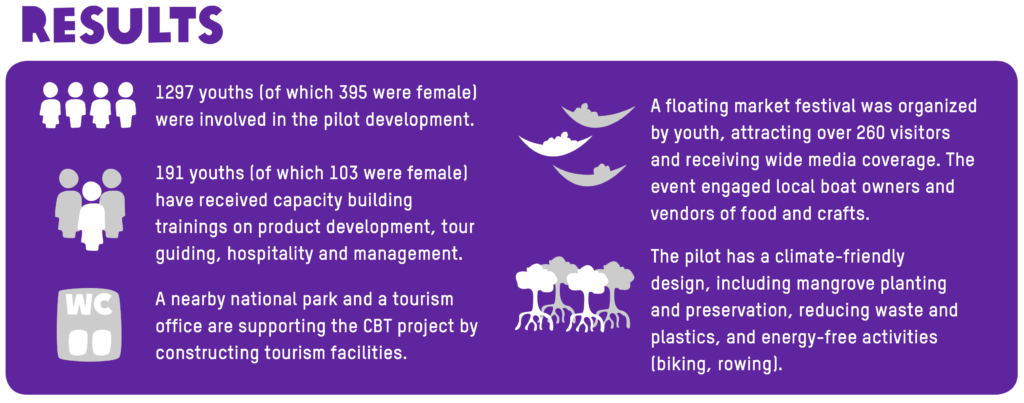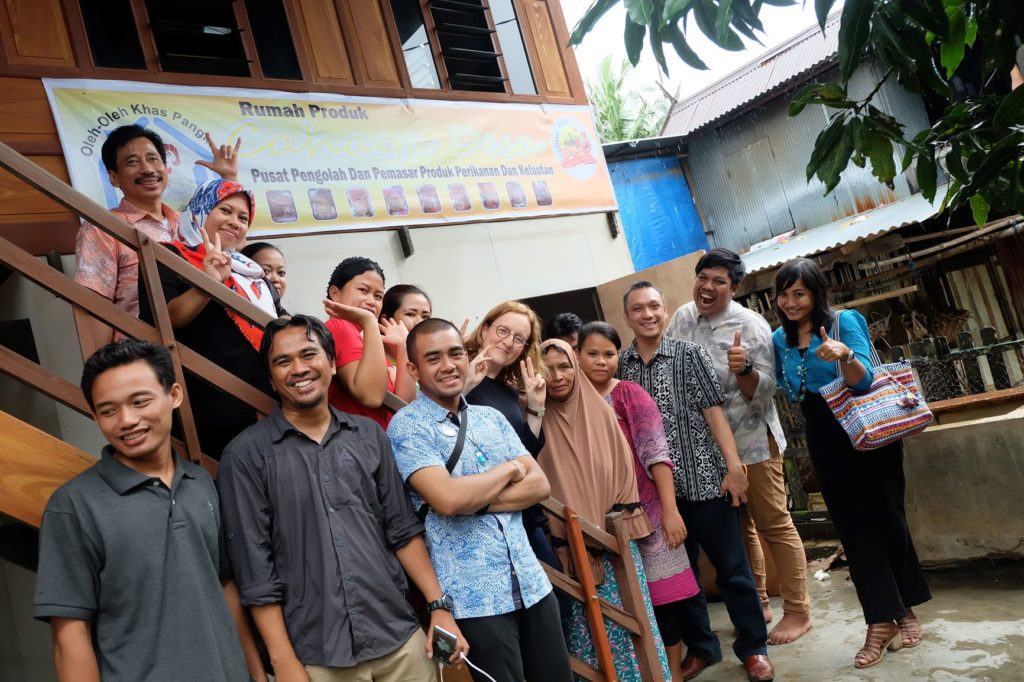Community-based tourism: A pilot from Indonesia
Community-based tourism (CBT) is an approach that enables young people and the community to preserve their natural and cultural heritage while making a living through tourism. In Indonesia, this initiative is implemented at youth-led, rural Youth Hubs.
What makes this pilot innovative?
The CBT initiative in South Sulawesi is supported by the local government and will be managed by youth and local communities to develop tourism which benefits them. It will also function together with the EYW Youth Hub. The youth are trained in identifying tourist attractions, communication skills, digital marketing, business skills and creating tours. Some examples include trekking, visiting caves and staying at local homes, where there is interaction with locals (e.g. cooking lessons, traditional clothing, daily life experience). This offers job opportunities such as a local tour guide, a homestay owner, boat crew, and more.
Before I joined the CBT hubs, I was not sure what to do after high school. During the project, I joined an interesting training on public speaking and tourism together with other youth that helped me grow more. I feel more disciplined and have better time management. Because of the CBT hubs, I noticed that I really like entrepreneurship. Near the place that I am living is an abandoned area, due to the training in CBT I see the potential to make it interesting for tourists. I have my own business, I sell body scrub at the hubs, in Makassar, and on the islands Papua and Kalimantan.” -Wahdaniar (18), female student and entrepreneur
Why in this region?
In Indonesia, 17% of the 43.3 million young people aged between 15 and 24 are unemployed in 2019 (according to World Bank and International Labour Organization statistics). In the targeted regions, over 10% of the population live below the poverty line. Most of these young people are caught in a poverty cycle as there are not enough employment opportunities. Likewise, Indonesia is a climate-vulnerable country, which makes climate-resilient employment even more important.
The districts Pangkep and Barru have very few industries and facilities, as most people are employed in agriculture. Many young people do not return home after finding employment elsewhere, and the youth that stay cannot find many work opportunities. Yet, both the districts are located in the Makassar-Toraja tourism corridor, which had over 5.5 million tourists in 2018.3 Before the pilot, the opportunities from this had not yet been captured.
Throughout the development of the CBT hubs and their products, 774 youths (of which 296 were female) were directly involved. Indirectly, 3,500 youth (1,225 female) have benefitted from the CBT hubs.

Methodology
The concept was inspired during an E-motive learning exchange between Indonesia and the Philippines on female entrepreneurship in rural areas. Indecon developed the CBT model and activities by making use of Human-Centered Design. Pankep and Barru were selected after a rapid assessment (including site, attraction, stakeholders, existence of youth groups). They are strategically located at the South Sulawesi tourism corridor and within the districts of EYW. Youth were actively involved throughout the development process.
[youtube ]

1) Initial assessment: This assessment identified several issues; tourist attraction, tourist facilities, infrastructure and accessibility, key stakeholder perspectives, related government regulation and tourism market. The assessment utilized many methods in which youth played an important role, including surveys and focus group discussions as well as HCD methods such as forming personas, interviews, design challenge, resource mapping and the photo walk.
2) Institutional assessment: Development of local institutions to manage tourism attractions and activities is essential for sustainability. The process depends on the society and the challenge each location had been facing. The aim was to strengthen any existing local organization that was interested in developing CBT, however, there were none in the regions. A workshop on institutional development was also conducted for wider stakeholders in Barru.
3) Planning: Community workshops were organized in each district, providing stakeholders with a basic understanding of CBT as well as developing a planning process. Experts then drafted a plan for project sites together with youth, village and local government.
4) Product development: This includes: i) an initial assessment, (ii) training on product development, (iii) youths developing itinerary and cost for the products, (iv) ensuring that the proposed products are coherent with the site plan. Some of the tours were then tested.
5) Capacity building: The youths and other stakeholders gained trainings on product development, tour guiding, hospitality and management.
6) Outreach: There were 9 CBT tour products developed by the local youth at the project sites. In addition, 4 local products were developed that could be sold (e.g. t-shirts and local food).

Lesson learned
- Low initial female participation. Young women were either occupied with domestic work or unable to travel far from the home. To address this, networks were initiated between female youth within the same CBT site for communal travel, and souvenir products were developed that can be made from home, increasing their participation from 21-27% to 27-33%.
- Limited seasonal opportunities, land and resources. CBT initiatives offer limited seasonal opportunities for employment. During off-seasons, selling handmade products or offering services that are less resource-intensive can help ensure continued incomes.
- Engaging the local community. Allowing time to build up trust with the community through regular engagement is important for success and sustainability.
- Coordination between different implementing partners. Activities should be well-planned, and the government should be included in all discussions to ensure that no obstacles arise.
- Activities during COVID-19 pandemic. Given the current restrictions on tourism, the CBT is adapting by still holding weekly trainings with the youths where they learn about business skills or invite a speaker from the government to talk about legal issues or products. The hubs also focus on other activities, such as eco-farming, to still obtain income.

Sustainability and scaling
After a year in operation, the CBT initiative has seen improved human resources, local organization and ready-to-offer products. The plan is to make a social enterprise out of the CBT hubs and strengthen relations with stakeholders such as local tourist organizations and the government. However, due to the current COVID19 pandemic, it is hard to predict when the tourism market will recover and if changes in services and facilities will be demanded. Therefore, a post-COVID19 strategy should be embedded in the further development.
